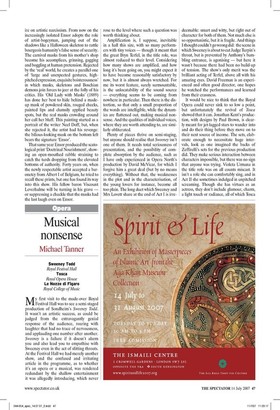Out of this world
Laura Gascoigne Masquerade: the work of James Ensor (1860-1949) Lady Lever Art Gallery, until 22 September Tt's hard to imagine a more unlikely place for a James Ensor exhibition than the Lady Lever Art Gallery in Port Sunlight, the squeaky-clean temple to Edwardian taste in art founded by Viscount Leverhulme on the profits of soap. Among the fragrant creations of Millais, Holman Hunt, BurneJones, Leighton, Waterhouse and co., the dark imaginings of this Belgian protoExpressionist look like dirty laundry tipped on to a parlour floor. 'I feel more English than most of the English artists now slavishly imitating the early Italians,' Ensor declared in 1900; now here he is holed up with this slavish crew — and to rub it in, one of them fronted his ticket. The exhibition Masquerade: the work of James Ensor (18601949) — his first outing in Britain since the Barbican's 1997 exhibition — is on loan to the Lady Lever from the Museum of Fine Arts, Ghent in exchange for Holman Hunt's 'The Scapegoat'.
However English he may have felt, this son of an expatriate British engineer and an Ostend souvenir shop owner has had scant recognition in this country: his only work in the Tate is an insipid still-life painted in 1935 when he was 40 years past his prime. Success in his native Belgium was almost as slow in coming. To the respectable citizens of Ostend, the solitary artist who dwelt among the shells, oriental curios, dried mermaids and carnival masks in his mother's shop was an embarrassing eccentric. He was too peculiar even for the Belgian avant-garde group Les XX, who rejected all his submissions to their 1888 exhibition. In retaliation, Ensor produced 'The Pisser' (1889), an etching of himself urinating against a wall decorated with children's drawings and the graffiti `ENSOR EST UN FOU'. That same year he also painted his monumental masterwork, 'The Entry of Christ into Brussels', not shown in public until 40 years later, when the Belgians belatedly woke up to the fact that they had an artistic genius in their midst and hung his entire oeuvre of 337 paintings, 135 engravings and 325 drawings in a retrospective at the Palais des Beaux-Arts.
Thirty of those engravings, plus three drawings and a painting, make up this show. They range in date from his very first etching of 1886, 'Christ Mocked', to three coloured prints of 1902-04 from his relatively late Deadly Sins series. Although he lived until 1949, Ensor peaked creatively in his twenties; half the engravings in this exhibition were made between 1886 and 1889. Despite this concentration, his print production is astonishingly varied. He could turn out a traditional landscape like the gloriously gusty 'Grand View of Mariakerke' (1887) with a breeziness of touch worthy of Rembrandt, or descend into the childish scrawl of 'The Infernal Cortege' (1886/7), with its snaking conga of phantasmagoric figures foreshadowing Picasso's 'Don Quixote'. He could conjure up a topographical print from hell, like the crumbling gothic vision of 'The Cathedral' (1886), bristling with gargoyles and set in a nightmarish sea of faces. He could do illustration (Hop-frog's Revenge', 1898), political satire (Belgium in the XIXth Century', 1889) and Batemanesque cartoon comedy (The Baths at Ostend', 1899). But his speciality was paranoid fantasy peopled with carnival masks and more skeletons than you could shake a scythe at.
Ensor had good reason to be morbid. In 1887 his alcoholic father fell down drunk in an Ostend doorway and died of exposure, prompting the deathbed portrait, 'My Dead Father' (1888). The following year, intimations of his own mortality take sinister hold in 'My Portrait as a Skeleton', a biting satire on artistic narcissism. From now on the increasingly isolated Ensor adopts the role of artist-bogeyman, jumping out of the shadows like a Halloween skeleton to rattle bourgeois humanity's false sense of security. The carnival masks from his mother's shop become his accomplices, grinning, gagging and boggling at human pretension. Rejected by the 'real' world, he creates a parallel one of 'large and unexpected gestures, highpitched expression, exquisite boisterousness' in which masks, skeletons and Boschian demons join forces to jeer at the folly of his critics. His 'Old Lady with Masks' (1889) has done her best to hide behind a madeup mask of powdered skin, rouged cheeks, painted lips and clumsily applied beauty spots, but the real masks crowding around her call her bluff. This painting started as a portrait of the writer Neel Doff, but, when she rejected it, the artist had his revenge: the bilious-looking mask on the bottom left bears the signature 'Ensor'.
That same year Ensor produced the scatological print 'Doctrinal Nourishment', showing an open-mouthed rabble straining to catch the turds dropping from the elevated bottoms of authority. Forty years on, when the newly respectable artist accepted a baronetcy from Albert I of Belgium, he tried to recall these prints, but one has found its way into this show. His fellow baron Viscount Leverhulme will be turning in his grave — or suppressing a chuckle that the masks had the last laugh even on Ensor.


















































 Previous page
Previous page